I came across the 2014 Indie film “The Babadook” while scouring the search engines of the internet for great new horror pieces to watch. With a truly frightening opening scene, a well acted performance from the two primary characters, and a great score done by Aussie musician Jed Kurzel, “The Babadook” proves true scares in film aren’t just a relic of the cinematic past.
The movie opens with single mother Amelia (Essie Davis) woken up by her 6-year-old son Samuel claiming there is a monster in his room. Amelia, Samuel, and the family dog embark on a checking of the usual places a monster would hide; under the bed, in the closet, a vanquishing of shadows, and determine the room is safe.
What makes Essie Davis great in that you can appreciate her dealings with her son in a routine that obviously occurs many times a week. The Australian born Davis hasn’t landed a leading role in a mainstream picture but has proved over a twenty-year career to be a solid and thoroughly professional actress.

Writer Jennifer Kent makes her directorial debut with the piece, and provides a perfect level of depth for the character of Amelia, who like her son is saddled with her own set of deep rooted emotional issues. “My dad’s in the cemetery.” Samuel advises everyone and anyone who broaches the subject. “He got killed driving my mother to the hospital to have me.” Kent tells a deep story and provides a perfect amount of scares to keep it going.
Amelia offers her son his choice of a book for her to read to him before bed one night, and Samuel selects a mysterious tomb called Mister Babadook. That Amelia has no knowledge of how it came about on the library shelf is strange enough – but the cover of the book gives off a troubling vibe on its own.
 A few pages in and Amelia is in utter dismay of the story – not a suitable bedtime fairy tale but a pop-up book with frightening images that depict an evil entity haunting a child at night. The chilling images are coupled with a grisly nursery rhyme that explains the story and forecasts the events that are about to transpire: “If its in a word or its in a look, you cant get rid of the Babdook.”
A few pages in and Amelia is in utter dismay of the story – not a suitable bedtime fairy tale but a pop-up book with frightening images that depict an evil entity haunting a child at night. The chilling images are coupled with a grisly nursery rhyme that explains the story and forecasts the events that are about to transpire: “If its in a word or its in a look, you cant get rid of the Babdook.”
What starts as a child’s un-credited fear of a monster becomes a much deeper rooted terror that affects Amelia as well. Nightmares begin to plague Samuel which in turn keeps Amelia from sleep, adding to her already stressful and burdensome existence. Amelia’s slow unraveling is revealed through her step by step deterioration; tension between her and her son, sitting in a bathtub fully clothed, and visions of the shadowy Babadook seemingly plaguing her everywhere.
The viewer is left questioning the true genesis of the terror – one angle is the mental issues suffered by both Amelia and Samuel, living alone in the shadows of the premature death of Samuel’s father. There’s the deeper psychological terror of loneliness as Amelia keeps seeing love, couples kissing, and happiness as a constant reminder of what she is missing. Anyone lonely can relate to being bombarded by an endless loop of happy couples on commercials, shows, or out in the street.
 At the same time, we wait for the impending arrival of the titular monster. Innocuous events like the dog scratching mysteriously on the basement door leave the element of a tangible Babadook in play.
At the same time, we wait for the impending arrival of the titular monster. Innocuous events like the dog scratching mysteriously on the basement door leave the element of a tangible Babadook in play.
One scene in particular is incredibly frightening as Amelia discovers the Mister Babadook book she had previously destroyed restored and filled with new lines; no longer is the monster going after the boy in the book, it is now going after his mother. “I’ll wager with you, I’ll make you a bet,” the new text reads. “The more you deny, the stronger I get.”
“The Babadook” is an independent film that didn’t get the promotion of a true Hollywood movie but its excellent in its mission – a perfect scary story.
by – Matt Christopher


